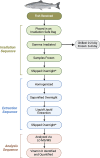The effect of gamma irradiation on the stability of vitamin D in select finfish species
- PMID: 41004494
- PMCID: PMC12469152
- DOI: 10.1371/journal.pone.0332867
The effect of gamma irradiation on the stability of vitamin D in select finfish species
Abstract
Finfish are an excellent source of dietary vitamin D and additional nutrients. Accordingly, their global consumption has increased. To meet this demand, finfish are now imported across large geographic distances. This poses several challenges, including the potential contamination of finfish with pathogenic bacteria, which can cause food-borne illnesses. Gamma irradiation is a potential solution with a history of reducing bacterial density in foods without compromising nutrients or taste. While some previous work has suggested that vitamin D is stable during irradiation, others have suggested that irradiation may reduce vitamin D. Importantly, these studies have not been completed in finfish tissue of commercialized species, which may offer cross-protection against any reduction in vitamin D. However, this has yet to be evaluated. In this study, three filets each of salmon and trout were dissected into multiple sections and each section was exposed to a different dose of gamma irradiation under both chilled (4°C) or frozen condition (-17°C). Here, we show that the stability of vitamin D during irradiation depends on finfish species and temperature in a dose-dependent manner. Specifically, we found that there was no significant change in vitamin D when trout was irradiated in the chilled or frozen state. Conversely, salmon showed a significant decrease in vitamin D when radiation doses exceeded 0.5 kGy in the chilled state and 2 kGy in the frozen state. Overall, our results indicate that irradiation of finfish may not reduce vitamin D concentration when applied at dosages of 0.5 kGy and 2 kGy or less in chilled and frozen conditions, respectively. Consequently, irradiation may represent a mechanism to increase the safety of consuming finfish while not impacting an important source of dietary vitamin D.
Copyright: © 2025 Brown et al. This is an open access article distributed under the terms of the Creative Commons Attribution License, which permits unrestricted use, distribution, and reproduction in any medium, provided the original author and source are credited.
Conflict of interest statement
Robert Smith is an author on a petition to the US FDA that seeks the approval of irradiation for finfish and flatfish.
Figures




References
-
- USDA. Seafood consumption per capita drifts higher in the United States.: Economic Research Service/ U.S. Department of Agriculture; 2024 [cited 2024 April 18]. https://www.ers.usda.gov/data-products/charts-of-note/chart-detail?chart...
-
- National Marine Fisheries Service. Fisheries of the United States, 2022. U.S. Department of Commerce, NOAA Current Fishery Statistics No. 2024. 2022. Available at: https://www.fisheries.noaa.gov/national/sustainable-fisheries/fisheries-...
-
- World Health Organization, Food and Agriculture Organization of the United Nations. Risk assessment of Vibrio parahaemolyticus in seafood. Part I. Geneva: World Health Organization; 2011. Available from: https://iris.who.int/bitstream/handle/10665/44566/9789241548175_eng.pdf
-
- Novoslavskij A, Terentjeva M, Eizenberga I, Valciņa O, Bartkevičs V, Bērziņš A. Major foodborne pathogens in fish and fish products: a review. Annals of Microbiology. 2016;66:1–15.
-
- World Health Organization, Food and Agriculture Organization of the United Nations. Risk assessment of Vibrio parahaemolyticus in seafood. Part III. Geneva: World Health Organization; 2011. Available from: https://iris.who.int/bitstream/handle/10665/44566/9789241548175_eng.pdf
MeSH terms
Substances
LinkOut - more resources
Full Text Sources
Medical

